Term 2 Unit 1 | Economics | 6th Social Science - Economics - An Introduction | 6th Social Science : Economics : Term 2 Unit 1 : Economics - An Introduction
Chapter: 6th Social Science : Economics : Term 2 Unit 1 : Economics - An Introduction
Economics - An Introduction
ECONOMICS
Unit 1

The laughter of children echoed
throughout the children’s park of that apartment. Some slided down joyfully
down the slide and some went up and down in the see – saw, shouting cheerfully.
Others were swinging so high and fast, in the swings as if they were about to
reach the sky. Some children were waiting near the swings to play next.
Kavin did not join with any of these
children. He sat alone in a corner, staring somewhere. His uncle Mohan noticed
Kavin and came near him.
“Kavin, are you going to play with your
friends?” asked his uncle as he sat next to Kavin.
“Uncle, everyone teases me, calling me
a villager,” said Kavin, with tears rolling down his eyes. “Even our Vimalan
laughs along with them. I came here for the holidays with so much of
excitement. Now, I regret my presence here. I want to go back to our village,
uncle,” sobbed Kavin.
“Is it so? Where is Vimalan?” asked his
uncle and started to search for his son in the crowd.
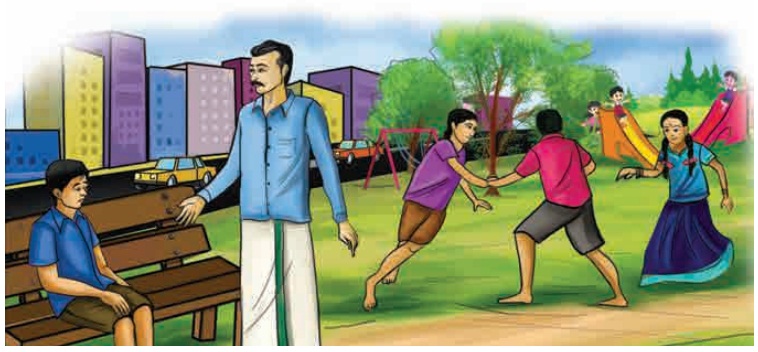
'Vimalan'... called him in loud voice.
On hearing his father’s voice, Vimalan enquired, “Did you call me, dad?” and
came near him.
“Did everyone tease Kavin?” asked
Mohan.
Vimalan didn’t utter a word. He stood
quietly.
“Even though I live in this big city, I
also hail from the same village. My roots are still there” said his father
worriedly. Then he added, “Go and bring your friends. I have to tell something
to you.” Saying this, he sat near Kavin.
When Vimalan brought his friends, his
father made them all sit down together. Mohan asked the children, “Let me come
to the point directly. Do you know from where do we get all the food?”
“The rice and pulses we eat? We buy
them from shops”, said Anandhan
“Tell me, where do the shopkeepers get these
things from?”
“I guess they would buy them from
another shop”.
“I think they would buy them from those
who grow crops, uncle”, said Inba.
“Correct! We call those people who
raise crops as farmers. Farming is the main occupation in villages”.
The children looked at each other in
surprise.
“The farmers grow various crops like
pulses, grains, vegetables etc., and send them to the shops in cities. We buy
and consume them”.
The amount from the income which is left for future needs after consumption is called savings.
“Uncle, I have a doubt”, said Kavin.
“Tel me, Kavin”
“In villages, I have seen people
selling all kinds of things in a place. Why do they call it ‘Sandhai’, instead
of shops?”
“Yes, Kavin,
HOTS:
Imagine if money
disappears one day?
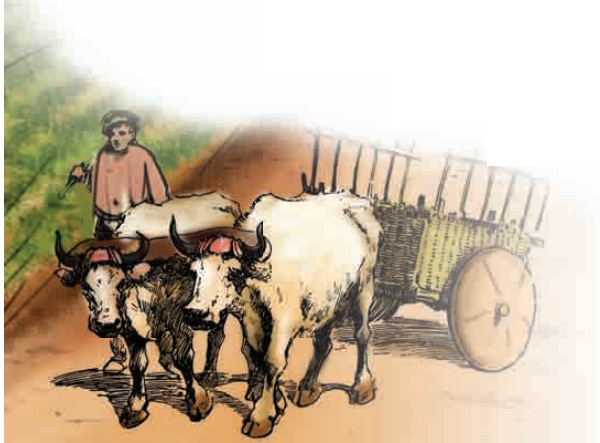
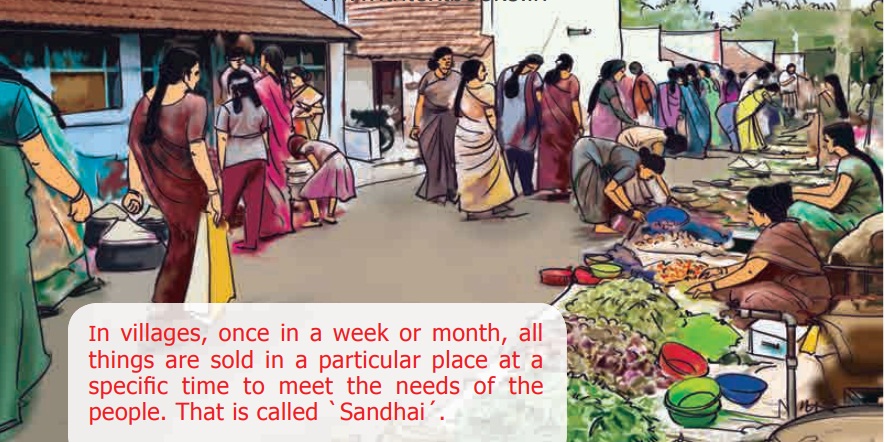
In villages, once in a
week or month, all things are sold in a particular place at a specific time to
meet the needs of the people. That is called ˋSandhaiˊ.
“Do you all know from where do they
bring these things to Sandhai?”
“We don’t know, uncle”, said the
children.
“I told you already that the things
which are produced in villages are brought to sandhai”.
“Fine, Kavin. Do you know what
activities are carried out in a sandhai?”
“Buying and selling”, said Kavin.
“Very good Kavin. Apart from going to
the sandhai with your mother, you have also noticed what’s happening around
you.”
Consumer Goods:
The finished goods which
are bought from the market to fulfi ll the daily needs of the consumers is
called consumer goods. Example: rice, clothes, bicycles, etc.
Hearing this, Kavin smiled.
All the children said in unison, ”Without
knowing the importance of villages, we teasted kavin. Forgive us, uncle, we won’t
hurt anyone herafter. We wish to know more about this”.
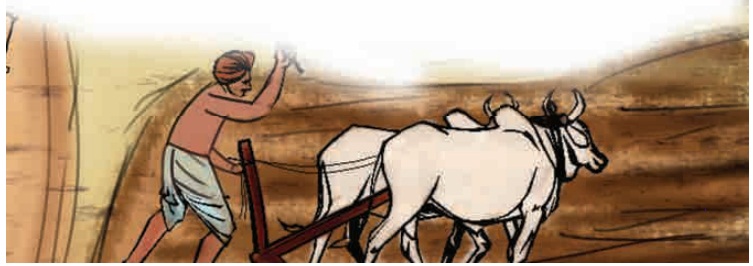
Activity 1
* Plan for a model
Sandhai.
* Ask the students to
bring vegetables and fruits to the classroom. [One student – one
vegetable/fruit].
* Ask them to display
like Sandhai and stick the prices of the vegetables .
* Other class students
can buy the vegetables.
* Through this activity,
the students can get an experience of the value of goods, buying, selling and a
knowledge of profit, loss, demand and supply.
* Probably the Sandhai
should be profitable. The students learn to fix the selling price through which
they can earn profit.
“Sure, I will tell you”, said Mohan,
“Small traders and other people buy
things from sandhai,” explained Mohan.
“Do you know in olden days we had a
system of exchanging goods for other goods, called barter system. For example,
exchange a bag of rice for enough clothes”.
“A person who has rice in surplus and a
person who has cloth in surplus, will exchange on the basis of their needs.
But, here the problem is that the person who has clothes should have the
willingness to buy rice. Only then, the exchange through barter system will
take place”.
“When they exchange commodities, they
may lead to certain problems, when comparing the differences in the value of
commodity. To solve this problem, people invented a tool called money”.
“Really. Is it so” exclaimed the
children.
“You know that early man, who hunted
and gathered food, later learnt to cultivate crops. When they found rivers
which provided them water, settled down permanently near the rivers. These
permanent settlements were called villages.
Agriculture remains to be the root of our economy even today. Man has no limits
for his demand and desire. Based on this, man started to learn new occupations.
Those who are involved in farming and grazing are called farmers or
cultivators”.
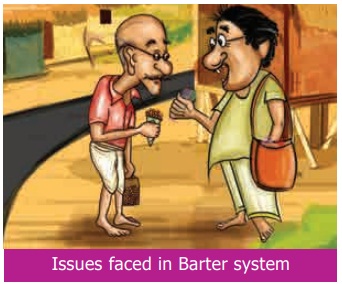
The amount from the
income which is left for future needs after consumption is called savings.
அளவறிந்து வாழாதான் வாழ்க்கை யுளபோல
வில்லாகித் தோன்றாக் கெடும்.
-குறள் 0479
விளக்கம்: தன் செல்வத்தின் அளவு அறிந்து அதற்கு ஏற்ப வாழாதவனுடைய வாழ்க்கை பல வளங்களும் இருப்பது போல தோன்றி உண்மையில் இல்லாதவனாய்ப் பின்பு அப்பொய்த் தோற்றமும் இல்லாமல் அழியும்.
“Is agriculture the primary
occupation?”
“Yes, there are certain other primary
activities like farming.
“Agriculture and industries are helpful
in the economic development of our country. Our country’s economy is based on
three economic activities”.
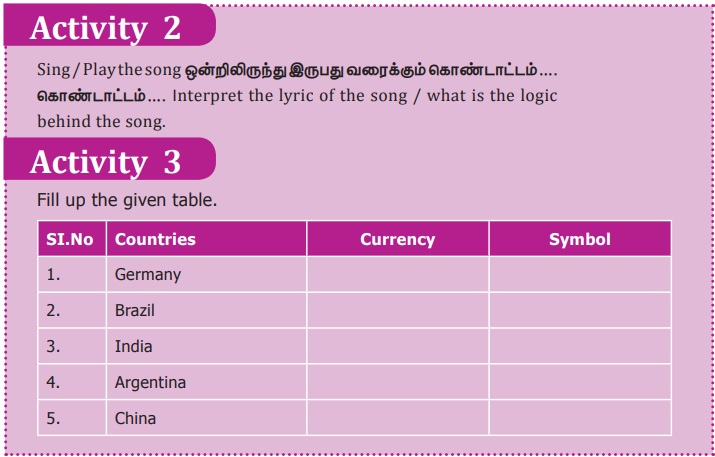
PRIMARY ACTIVITIES
They are concerned with
the production of raw materials for food stuff and industrial use. Primary
activities include
* Agriculture
* Cattle rearing
* Fishing
* Mining
* Collection of fruits,
nuts, honey, rubber, resin and medicinal herbs, lumbering
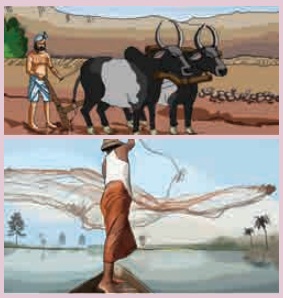
“Is agriculture confined only to
villages? What other works do the villagers do?”
“What will a village look like uncle?”
interrupted Inba.
“Agriculture is the primary occupation.
There won’t be any kind of facilities like our cities. At the same time, they
get their basic needs fulfilled easily. There are small shops. Vegetables are
grown in abundance, just like rice and pulses. Though the sugar that is added
in our milk, coffee and tea is produced in sugar mills, the raw material
sugarcane is cultivated in villages. From chilies to mustard, all those
provisions used for food are grown in villages.”
“Wow! My mother told me that these
things are very expensive. Therefore, the villagers must be so wealthy!” said
Adithya.
“No, not like that. They are just
producers. Their products are bought and sold by some mediators. So, the
farmers get very little money”.
“What a pity! But the villages are the
real shadows of cities”, exclaimed Anandhan.
“Even Gandhiji has said that the villages are the backbone of our country”.
“Yes, what a wonderful saying!” said
Kavin excitedly.
At that time, the mobile phone rang.
Mohan attended the phone. Vimalan’s mother Ponni had called.
“What are you chatting about with the
children for so long? The food is ready. Bring them home”, saying so, she cut
the call.
“Children, come, let’s go home. Food is
ready” Mohan got up and the children followed him with joy.
Inba asked, “Uncle, you said how
villages are important. Aren’t cities important?”
“No Inba. Both cities and villages are
important on their own”.
“If it is so, tell us about the
importance of cities”, asked Inba again.
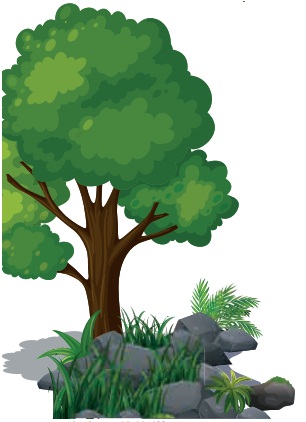
“That is good. I will tell you. More
than 50 percentage of the world’s populations live in cities. In our state
Tamil Nadu, 47 percentage of the people are in cities,.
“Wow!” they exclaimed.
“Not only that. Tamil Nadu is well
developed in secondary and tertiary activities as well. These are city centered
activities.”
“We feel very proud to hear this uncle.
Tell us about those activities”.
Uncle Mohan said, “Well, apart from
this, employment opportunities are more in cities than villages. People
involved in small scale industries and unorganized sector are mostly found in
cities.”
“We don’t understand.”
“In villages, there are only a few
saloons and laundry shops. But, in cities the number of such small scale
workers are more. This results in additional income in cities."
SECONDARY ACTIVITIES
The raw materials
obtained from the primary activities are converted into finished products
through machinery on a large scale. These activities are called secondary
activities.
Industries are classified
on the basis of the availability of raw materials, capital and ownership.
• On the basis of raw
materials, industries are classified as
• Agro based industries –
Cotton textiles, Sugar mills and Food processing.
• Forest based industries
– Paper mills, Furniture making, Building Materials.
• Mineral based
industries – Cement, Iron, Aluminium Industries.
• Marine based industries
– Sea food processing
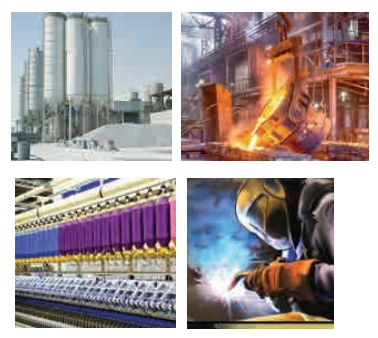
“Really?”
“Yes, well paved roads, ports, airports
and railway stations support trade. Many branches of banks help in the
circulation of money and boost the country’s economy. All these are termed as
tertiary activities.”
Vimalan exclaimed, “Even being in the
city, I never knew about all these.”
Inba said, “We really got to know more
information, uncle”
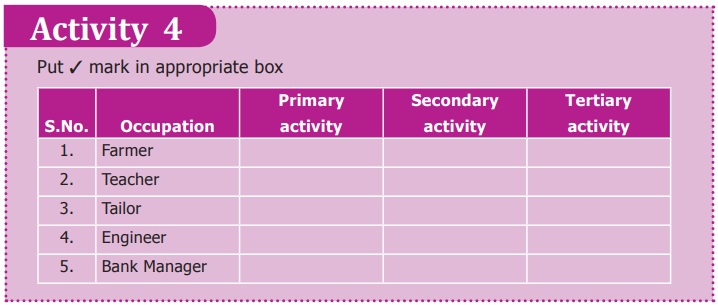
TERTIARY ACTIVITIES
“I already told you that
industries produce goods and distribute them to the people. For this purpose,
some services are required. These services are called tertiary activities or service sectors. The service sector serves
the people to fulfill their daily needs like:
• Transport – roadways,
railways, waterways, airways
• Communication – Post,
Telephone, Information Technology etc
• Trade – Procurement of
goods, selling
• Banking – Money
transactions, banking services

“Good, will you compare cities and
villages in the future?”
“Never, we won’t say such a thing. If
anyone talks like that, we will explain whatever we have learnt from you”
replied the children.
Come lets go and have our lunch”. Said Mohan.
Children said that they will come after
playing for some more time.
Holding Kavin’s hand, they all ran
towards the park.
Mohan, an economics teacher, felt proud
of their unity and satisfied of clarifying something good to the children.
LEANING OUTCOMES
• Children understand the
meaning of Sandhai.
• Get clear idea about
the barter system.
• Gain knowledge of the
various
GLOSSARY
1.
Consumer – the one who uses the
products
2.
Commodity – products
3.
Occupation – work / Job
4.
Settlement – living place of
human being
Related Topics